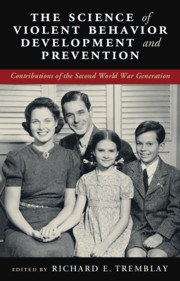 The Science of Violent Behavior Development and Prevention
The Science of Violent Behavior Development and Prevention Book contents
- The Science of Violent Behavior Development and Prevention
- The Science of Violent Behavior Development and Prevention
- Copyright page
- Contents
- Preface
- 1 Introduction: A Young Science with a Long History
- 2 From Birth in a British Orphanage to Assessments of American Indians’ Development
- 3 From Rationing, Illness, and Stress to the Creation of a Major Longitudinal Birth Cohort
- 4 From Country Girl in Southern Finland to Longitudinal Research into Alternatives to Aggression and Violence
- 5 From the Occupied Netherlands to the Pittsburgh Longitudinal Studies
- 6 From Boy to Man
- 7 Nurture and Nature
- 8 From Unruly Child to Political Protester and Promoter of an Ecology-Minded Concept of Development
- 9 From the Frustration–Aggression Hypothesis to Moral Reasoning and Action
- 10 A Tortuous Path towards Understanding and Preventing the Development of Chronic Physical Aggression
- 11 From Childhood in a Ruined German City to Research on Crime and Violence
- 12 The Last War Baby
- 13 Comments on the Autobiographies of the World War II Babies by Younger Peers
- Index
- References
7 - Nurture and Nature
Surviving in the Shadows of War
Published online by Cambridge University Press: 28 January 2021
- The Science of Violent Behavior Development and Prevention
- The Science of Violent Behavior Development and Prevention
- Copyright page
- Contents
- Preface
- 1 Introduction: A Young Science with a Long History
- 2 From Birth in a British Orphanage to Assessments of American Indians’ Development
- 3 From Rationing, Illness, and Stress to the Creation of a Major Longitudinal Birth Cohort
- 4 From Country Girl in Southern Finland to Longitudinal Research into Alternatives to Aggression and Violence
- 5 From the Occupied Netherlands to the Pittsburgh Longitudinal Studies
- 6 From Boy to Man
- 7 Nurture and Nature
- 8 From Unruly Child to Political Protester and Promoter of an Ecology-Minded Concept of Development
- 9 From the Frustration–Aggression Hypothesis to Moral Reasoning and Action
- 10 A Tortuous Path towards Understanding and Preventing the Development of Chronic Physical Aggression
- 11 From Childhood in a Ruined German City to Research on Crime and Violence
- 12 The Last War Baby
- 13 Comments on the Autobiographies of the World War II Babies by Younger Peers
- Index
- References
Summary
Menno Reindert Kruk was born in 1944 in the Netherlands. He did his PhD on the ‘Origins of Hypothalamic Aggression’ and became President of the International Society for the Study of Aggression. He coordinated Hungarian-Dutch cooperation on ‘Stress and Aggression Interactions’ and an interdisciplinary multicenter research program on the ‘Neuroanatomy and Temporal Structure of Hypothalamic Responses’. His main research focus was the interaction between brain function, hormones, and behavior, with the aim of understanding brain mechanisms during violent behavior. He specifically explored how aggression could be studied using methods from the natural sciences and animal models, first to clarify which hypothalamic neurons mediate attack during electrical stimulation and then to register their activity during social interactions in order to understand ‘pathological’ processes in aggression. The research methods he used included ethological, pharmacological, endocrine, physiological, and mathematical approaches. He developed animal models of functional and pathological aggression and the mathematical tools to describe and analyze the effects of drugs and hormones on behavioral structure and on social interactions between animals. He studied the crucial role of corticosteroid feedback to the brain for the control of aggressive behavior and studied the interactions between the processing of conflict-related stimuli and stress hormones in humans.
Keywords
- Type
- Chapter
- Information
- The Science of Violent Behavior Development and PreventionContributions of the Second World War Generation, pp. 155 - 187Publisher: Cambridge University PressPrint publication year: 2021
